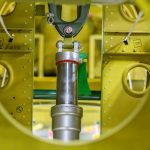WarbirdsNews has just received the March, 2019 report from Chuck Cravens concerning the restoration of the Dakota Territory Air Museum’s P-47D Thunderbolt 42-27609 at AirCorps Aviation in Bemidji, Minnesota. We thought our readers would be very interested to see how the project has progressed since our last article on this important project. So without further ado, here it goes!
Update
This month the restoration milestones include the tail wheel installation and the assembly of the firewall extension. We’ll check those out and incorporate the last installment of P-47 history.
Tail Wheel Installation
The Thunderbolt’s tail wheel had to be strong and reliable to ensure safe take offs and landings at weights as high as 17,000 pounds for the P-47D-23 and as much as 21,000 in later N models. The tail wheel locks straight ahead after taxi and is released from the locked position after landing to enable the Thunderbolt’s ability to turn on the ground.
Main Gear Wheels
Fuselage and Firewall Extension
P-47 History Part 4
The Thunderbolt is justifiably famous for ground attack missions in the European Theater of Operation.
But the P-47s ground pounding history didn’t begin in Europe. While close air support of ground forces dates back to World War I, the air-to-ground communication of the time was very primitive during that conflict, which limited effectiveness.
However, the fighter-bombers of the Allied and Axis powers in the Second World War were far more effective. For the USAAF in World War Two, close air support of ground troops was pioneered in New Guinea during the summer of 1942.
Long an advocate for ground attack, Fifth Air Force commander Major General George C. Kenney had taught a class titled “Attack Aviation Course” in 1937, and wrote the textbook for it.
Kenney turned theory into practice when 5th Air Force A-20 Havoc light bombers strafed Japanese positions in support of Australian troops. The A-20s had been modified by Major Paul “Pappy” Gunn by adding four .50 caliber nose mounted guns that he salvaged from wrecked fighters.
General Kenney ordered his fighter groups to develop ground attack tactics after seeing the success of the A-20s. Early 5th AF ground support missions were carried out with P-39s, P-400s ( export version of the P-39) and P-40s.
When the formidably armed 8 gun P-47s arrived in the Southwest Pacific Theater in late 1943, they naturally were used in the ground support role as well as the air-to-air combat missions.
Close air support missions continued during Operation Torch in North Africa. In November 1942, Twelfth Air Force Commander, General James Doolittle, like Kenney, assigned the initial close air support role to A-20s. Later, fighters carried out ground support missions, mainly P-40s and P-38s. RAF pilots who had been flying CAS missions and developing tactics since 1940, shared their experiences and provided some close air support training to the Americans.
As the war progressed, the Twelfth Air Force moved on to Italy; Thunderbolts were used extensively for ground attack in that campaign.
The effectiveness of the Thunderbolt’s eight .50 caliber Brownings, and the aircraft’s ability to carry a significant bomb load on dangerous ground support missions in Papua New Guinea, made it a natural choice for close support missions during the Normandy invasion and subsequent march across France into Germany. The P-47’s fighter-bomber role or Jabo (short for the synonymous German word “jagdbomber”) is best known from the European Theater’s extremely effective though perilous ground attack missions following the invasion.
While various sources list slightly different totals, Thunderbolts have been credited with the destruction of an estimated 6,000 tanks and armored vehicles, 9,000 locomotives, 86,000 railroad cars and other rolling stock, and 68,000 trucks during the war [Ref. Jerry Scutts, Republic P-47, The Operational Record, 1998, MBI Publishing Company LLC]. Of course, the number of enemy troops killed or wounded by P-47 fighter-bomber attacks will likely never be known accurately.
Besides the USAAF, P-47’s were sold or supplied to Brazil, Free France, Mexico, the UK, and the USSR during WWII. Fifteen foreign countries and a few USAF reserve units flew the P-47 after the war.
And that’s all for this month. We wish to thank AirCorps Aviation, Chuck Cravens (words) as well as John LaTourelle (images) for making this report possible! We look forwards to bringing more restoration reports on progress with this rare machine in the coming months.
Is the P-47 Thunderbolt your favorite airplane? Make sure to purchase issue #73 of Warbird Digest featuring the beautiful “Dottie Mae”


























































